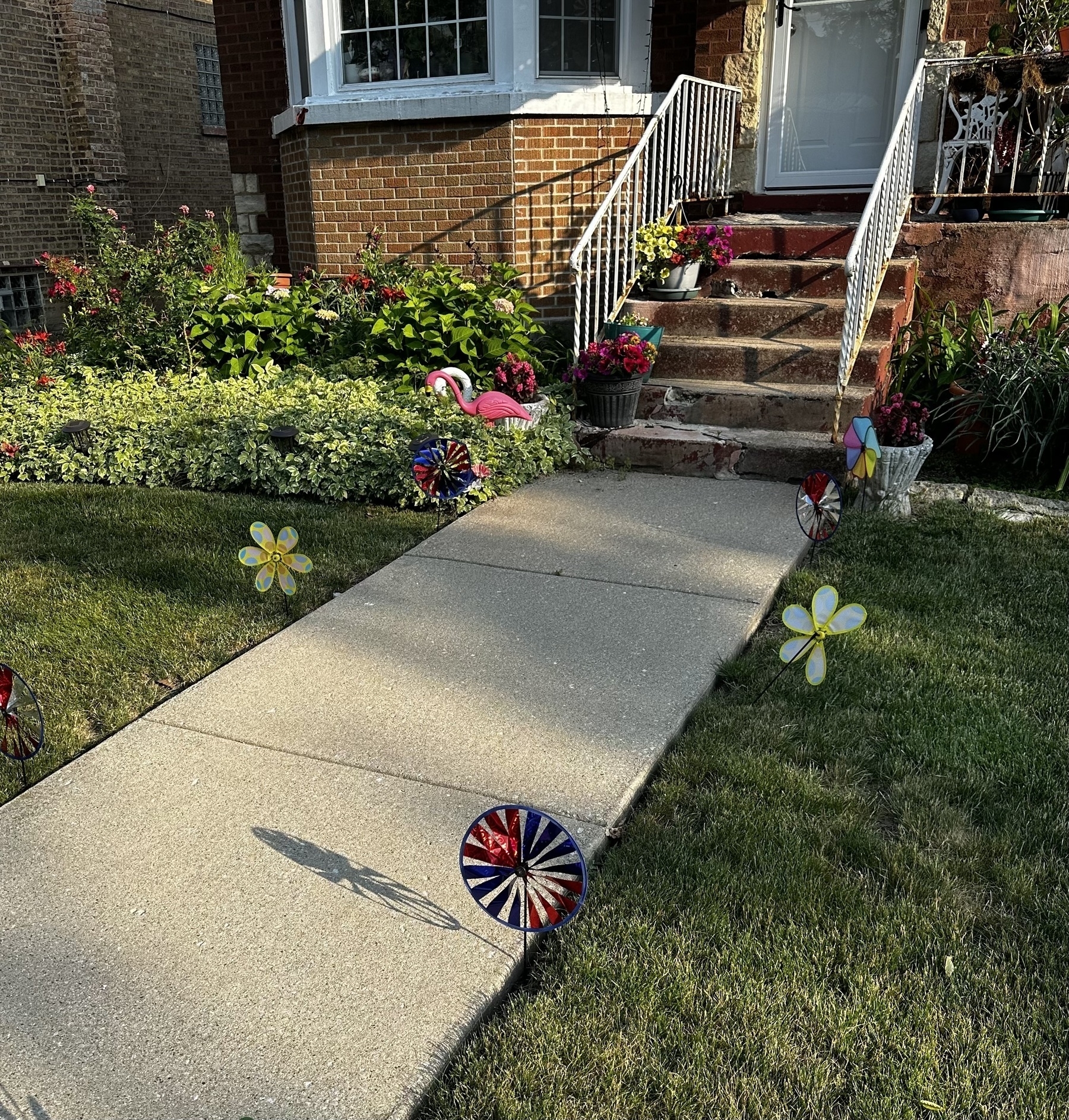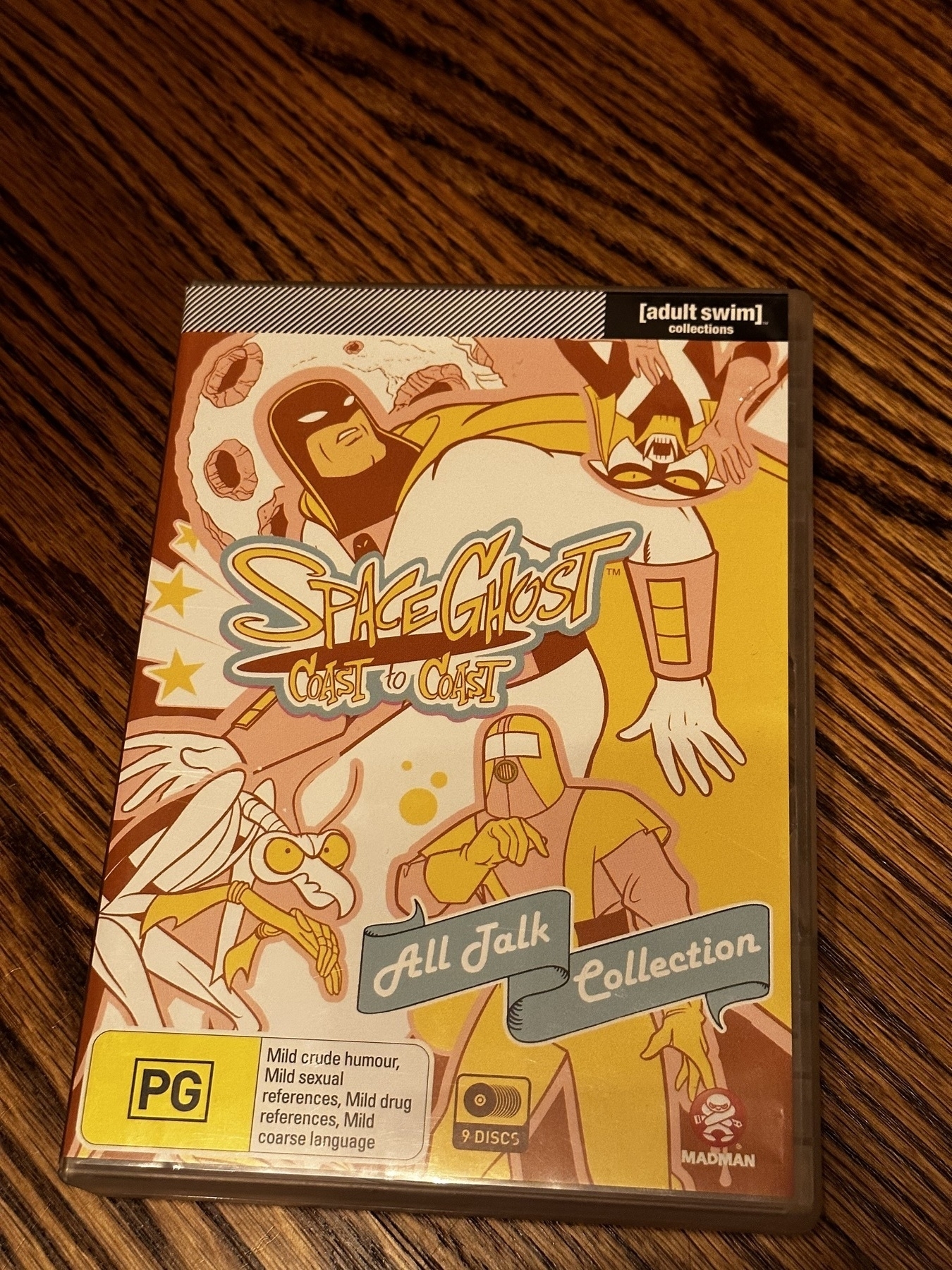-
The Super Mario Bros. Movie was better than I expected:
- Fast-moving: I’d forgotten the joy of a 90-minute film.
- Beautifully animated: The 🌈 road sequence!
- Deep references: E.g., the Mario v. DK fight echoed the 1981 Donkey Kong.
Now time for some Donkey Kong (1994) on my Analogue Super NT.
-
This beer manages to taste smooth and almost sweet despite being 9.5% ABV.

-
Glimpsed this faint🌈 over Super H Mart last night

-
These Chicago-style hotdogs were really good:
- poppy seed bun
- dill pickle spear
- neon green sweet relish
- sport peppers
- chopped white onion
- tomato slices
- yellow mustard
- celery salt

-
A handful of Game Boy games can, when connected to a Super Nintendo/Famicom (SNES/SFC) via a Super Game Boy/2, use the SNES/SFC hardware to play back a soundtrack that would’ve been beyond the audio capabilities of the Game Boy hardware. Here are three such games:
- Toy Story
- A Bug’s Life
- Animaniacs

-
Loved this tree at my doctor’s office.

-
What is Dolby Atmos?
Dolby Atmos is having a moment. Although the immersive audio format dates back to the first term of the Obama administration 1, for most of its life so far it’s only really been known to the niche audiences of movie/home theater enthusiasts and Blu-ray Disc collectors.
That changed with its adoption by Apple Music. Anyone subscribed to the service can stream any Atmos-encoded songs in its catalog, at no extra charge. Along with lossless quality 2, Atmos is a key differentiator for Apple Music from Spotify, which right now supports neither of those enhancements.
The Atmos basics
Now here’s the tough part: What is Atmos?
Even as someone who’s been immersed (pun intended) in its world since the early 2010s, I still struggle to explain it to most people. Fundamentally, it’s metadata embedded in a Dolby TrueHD or Dolby Digital Plus stream, with information about where a sound (codified as an “object”) should be played relative to other sounds within a 3-D map of a theater or home. The New York Times (gift link below) offered a pretty straightforward explanation this month:
Dolby Atmos, introduced in 2012, was initially developed for movie theaters and the home theater market. Because it offers a wider palette than stereo, and differs from traditional 5.1 and 7.1 channel setups, Atmos allows engineers—typically mixing across a dozen or more speakers—to put sound sources in front, to the side, behind and even above the listener.
So:
- More, more, more: It’s more complicated than stereo (i.e., two channels), with the ability to assign over 100 total objects in any direction. Accordingly, to get Atmos playback, everything in the chain—the master recording, the delivery service (such as Apple Music), and the playback equipment—must support its proprietary technology. The simplest setup for most people will be Apple Music plus AirPods; a more complex setup would be something like a 4K Ultra HD movie with Atmos soundtrack, a compatible disc player, and an Atmos/capable home theater.
- Spatiality: It emphasizes spatial audio that comes from multiple directions at once and/or moves around in a seemingly “3-D” way. For example, with AirPods on, if you set your phone flat on a table and then walk around it, it’ll feel like the vocals in the song (if it has them) are hitting your ears from different directions as you move—a good demonstration of how Atmos always maintains relative spacing between its objects.
Still, when I first heard about Atmos in 2014, I wasn’t clear how it differed from the (also-immersive) surround sound setups that movie and home theaters had used for years. But there are both subtle and overt differences:
Subtle
Atmos consists of audio “objects” that are specified as rectangular coordinates within a specific three-dimensional space, such as a theater or a sound system.
For example, Object A can be mixed to be “above” Object B, and so when it comes out of the speaker system it’ll seem like it’s coming from a very different source location.
The key is the relative positioning of such sounds as coordinates in 3-D space. This design means that Atmos content isn’t locked to or defined by presence in specific discrete channels, which can seem like a benefit or a drawback depending on your perspective:
- On the “benefit” side, you don’t need speakers that are in a specific configuration, e.g. center, rear-left, surround/right, and so on, because Atmos is adaptive and can keep sounds in the right relative spacing even when coming from a single Atmos-enabled speaker, which may use drivers to send sounds in distinct directions. In this way, Atmos allows for simplified setups.
- On the “drawback” side, it’s an open question if the simulated surround sound (basically, the sensation of sounds moving around in coordinated space despite only coming from a somewhat simple set of speakers or even headphones) they get from Atmos is a good or even close approximation of the 6 or 8 discrete channels on a traditional setup.
Overt
If someone knows anything about Atmos, they know that it has vertical channels. Many Atmos soundbars have speakers on the top, to fling audio toward the ceiling.
Helicopter sounds are a famous Atmos use case, because the verticality that Atmos allows can make it seem like the sounds of the rotating blades are coming from directly above you.
There is a rival technology called DTS:X that works virtually the same way.
But is it worth it?
Whenever a new commercial sound format like Atmos comes along, I feel like it’s healthy to be initially skeptical of it. That’s because these innovations are often presented as offering, at great cost, richer sound that meets the standards of self-proclaimed “audiophiles,” whose claims—about how you can hear sounds with noticeable improvements in clarity solely via better encoding and playback technology—unfortunately usually lack strong evidence.
It’s fine to be an audiophile about something like noticeable background noise on a podcast 3 or heavy distortion on a song that’s been mastered so “hot” that even listening to it on a low volume can hurt your ears. But audiophile arguments about basically any of the following strike me as shaky:
- Lossless audio: It’s a lot of extra data for virtually no change in perceived quality.
- “Hi-res” anything: Movies like Akira pioneered really high sample rates (the so-called “hypersonic effect”) that like the above don’t seem to sound any better than more modestly produced audio.
- Super Audio CD/DSD: A failed format/technology that offers much higher bitrates than CD as well as 5.1 surround. Blind listening tests couldn’t identify SACD vs CD at any rate above chance, i.e., of flipping a coin. The 5.1 piece is different, because that is distinct from stereo-only CDs, but playing back a 5.1 SACD mix is almost impossible without a Blu-ray player with 6+ RCA jacks.
- “3-D” sound: This is the marketing lingo around Atmos and it seems strange if only because our world is 3-D already and we hear sounds from different points constantly.
The truth is that the human ear has a very limited frequency range, especially compared to animals such as cats, and this range deteriorates with age. Stereo CD audio, which is 16-bit with a 44,100 Hz 4 sampling rate and a 20 Hz to 20 KHz frequency response, is already beyond the range of what a human adult can perceive
Side note: Vinyl and tape are far worse in this respect, so yes the CD really was a big breakthrough and an exception to the audiophile skepticism outlook I proposed above. It allowed for more dynamic range—there are bass frequencies I can hear on the CD version of the Captain Hollywood Project’s Animals Or Human that I can’t hear on the vinyl—and it also doesn’t degrade with each listen like analog media do.
We also only have two ears. Stereo sound is usually superior to mono, at least for music (podcasts are a different story) for this reason. I’m not clear that a similar jump can be made with spatial audio, and one of the audio engineers interviewed by the NYT had similar thoughts:
She noted that there are evolutionary and biological reasons that sound sources coming from behind and above listeners can be unsettling or anxiety inducing. She also observed that music is a potent form of communication in large part because the consummatory phase happens entirely in the listener’s head. Having clearer and more sound sources can actually make it harder to know what to pay attention to.
My own experience listening to Atmos has been that it seems cool sometimes—I liked how the voices and sound effects were spaced in the mix on George Miller’s Three Thousand Years of Longing—but overall it seems a lot like old stereo (on headphones) or surround sound (in home theaters) to me.
On headphones
AirPods are still relying on just two speakers to deliver their 3-D sound. The upcoming Apple Vision Pro may go further, but I mostly agree with the quoted interviewee that we may be getting a lot more audio information that we won’t know what to do with and that won’t enrich our listening experience.
In home theaters
Setting up a proper home theater is difficult. I had to place the speakers in my 5.1.2 (that’s five channels plus one subwoofer and two Atmos height channels) system strategically, ensure that I was using the HDMI eARC port correctly, and learn about how Dolby TrueHD differed from Dolby Digital Plus 5.
“Wait, timeout” you’re probably saying. “I thought Atmos was supposed to replace 5.1 and 7.1?”
It is, sort of—Atmos offer the potential for an immersive surround sound-like experience with fewer speakers and configurations, but it can also be supported on newer iterations of the same types of complex home theater systems it’s positioned as an alternative to.
On such systems, Atmos to my ears doesn’t differ much from the old 5.1 or 7.1, with the exception of occasional vertical sounds. People in the market for simple Atmos home sound systems (e.g., a 2.1 soundbar with Atmos) were probably never going to set up a 5.1 or 7.1 system, so Atmos really is something new and exciting.
The proprietary march goes on
Dolby Atmos is proprietary technology from a company whose business model Knives Out cinematographer Steve Yedlin has called “charging for extra signal processing.”
A cynical take on Atmos would hold that it’s all part of a scheme to make even the act of listening to music on headphones more expensive and exclusive. It’s off a piece with the removals of standard headphone jacks from phones. The implication will be that you can’t get the “full” experience without a full Atmos sound chain.
I’m not sure I’m that cynical yet. However, I do think Atmos is akin to other diminishing-return innovations such as 4K HDR and the Apple Vision Pro, in that it seems to oversell itself because its predecessors (stereo audio, 1080p video, and the smartphone, respectively) are still more than good enough for the use cases it purports to solve. It’s a fascinating concept but its biggest effects seem to be not on how much people enjoy what they’re hearing and seeing, but on the creation of long meta-takes and explainers like this one and the NYT piece.
-
I like to phrase time this way because it makes it seem much longer ago than if I’d just said “11 years ago.” ↩︎
-
Lossless audio, like that on a CD, almost always sounds no different than a lossy MP3. ↩︎
-
I’ve struggled with this issue myself. GarageBand has some plugins that help but my recording environment is just not soundproof enough. ↩︎
-
44,100 is the product of the squares of the first four prime numbers (2, 3, 5, and 7). ↩︎
-
For example, you can’t carry TrueHD on a S/PDIF optical or coaxial cable. ↩︎
-
My original 1998 cart of The Legend of Zelda: Link’s Awakening DX for Game Boy, running on an Analogue Super NT via a Super Game Boy 2, a 🇯🇵 only successor to the original SGB with accurate playback speed and a new link port.
- 1080p
- 8:7 aspect ratio overall
- 10:9 aspect ratio for the game itself

-
Nap time

-
The long refactor
In 2000, I took a high-school computer science class (“Computer Applications” was the course title) on HTML. We learned to write our code in Notepad on Windows 98, and ever since I’ve been biased toward composing everything—from web code to 5,000-word freeform explorations that mix poetry with blogging—in barebones text editors 1.
This acquired behavior is my entire experience with coding in miniature. I didn’t become a coder per se, because I’ve never written code for money and wouldn’t consider myself proficient at it. (Please don’t hire me to code your site or application!).
But coding did refactor how I wrote, even deep in the darkest Dikaeopolis-translating magical abysses of the humanities, when I was, for instance, dealing with the technical debt of rewriting a blob of first-draft prose about Plato.
Refactoring the writing process
Indeed, my cursory time working with code in a structured academic setting profoundly affected both the form and function (pun intended) of my philosophy writing:
- Form: Composing in Notepad made me partial to shorter blocks of text chiseled out quickly. It also demystified the writing process for me: Instead of doing a whole big ritual, waiting for inspiration as the blank Word page anti-beckoned and trying to write the text to make all other text obsolete, I saw writing instead as just input (my fingers flitting, my brain bursting) for a corresponding output (ideas, emotions). I knew I had to start it, instead of thinking too much beforehand (although mentally rehearsing lines and doing calculations while away from the editor was still important). The plainness of Notepad reinforced this “act-now” mentality then, just as apps like Tot do now. When I wrote that senior thesis on Plato’s Timaeus, my methodology of writing quickly in a plain text editor let me move with a speed and an un-sentimentality 2 that’d have been impossible for me, the hyper-anxious person, if forced to do it somewhere more ornate without decomposing it into little code-like chunks, into the writing equivalent of functions.
- Function: When I came to what my writing did, I thought of it as a big series of shortcuts, many of them borrowed from others a la programmers taking from Stack Overflow, rather than as an exhausting fully “original” all-out effort each time. I aimed to bring novel ideas out into the open, but nothing’s truly original 3 and basically every notion requires someone else’s notion—much as a wrapper function in programming requires another function. What if I just created a wrapper function, er, a citation to another scholar’s work, to explain this section of the Timaeus, instead of trying to rephrase it from scratch?, I asked myself at one point, remembering abstractly how in a latter computer science class, in 2003, I learned how to write basic C++ code that began with the “include <iostream.h>” library each time—a shortcut of sorts.
Coding made me a better humanities writer. Likewise, my time studying Greek and Latin in college undoubtedly helped me with understanding seemingly unrelated technical concepts. Both of those languages work very differently than English 4 and there’s entire new syntaxes, ways of arranging sentences, ways of thinking involved in learning them. Parsing their code within texts by authors such as Aristophanes and Menander felt familiar, like looking over my rudimentary HTML and C++ code for errors.
In these ways, expertise is non-linear. It doesn’t come solely from learning Subject A from the basest basics to most advanced advances; knowing something about tangential Subject B and also Subject C can enlighten you in ways you’d never anticipated. This is why I think liberal arts education is so valuable.
Getting creative
In those high-school CS classes, I’d learned how (some) technical people use a favored stack of tools to work toward predictable results. Plus, I’d picked up on their distinctive vocabulary (“memory leak,” “setting up your environment,” and so on) and had it written into my memory (hah!), and I eventually became comfortable enough doing things that are somewhat beyond the totally nontechnical—updating DNS records, writing TOML files, understanding what JSON does—albeit trivial for true “hackers.” 5
My technical affinity then led me to blogs such as Daring Fireball and to platforms like Mastodon, which is how I discovered tools such as Tot and MarsEdit, as well as languages such as Markdown 6. All of this expanded knowledge, in an area that wasn’t even my specialty, gave me the infrastructure to produce even creative writing that I’d have not been up to writing had I stuck to the humanities only.
I’ll leave this post with a segment I composed in a flurry within the stark simplicity of Tot, while trying to come up with ideas for a blog post about why I struggled with “separating the artist from the art.” The scratchpad ideas turned into their own thing, a perfect demonstration of how taking a utilitarian approach can yield satisfying (to me, at least) results:
When Larson and Watterston retired in 1995, I had no notion of who they were as people. I was inside a Kentucky convenience store on the day Larson gave up and bequeathed not so much as a searchable image description-laden online database of his work: Naive, I would’ve thought much later at a time that’s now mercifully long ago, what a total fool so behind the Gutenberg-praising journalism professors who think physical books are passé. There was a newspaper with The Far Side assuredly folded up inside of it, inked panels all deathly still between the mausoleums of moveable type encircling them, all their lined dogs and curved farmers just unseen, de-folded origami pressed tighter by their identical twins above and below them on the rack, and my first association with Larson’s name remains, even in this moment, no humanoid face, but a bovine figure (it’s “fun” to read that as both a French and an English word) puzzled by their spotty tools. The clerk is a lemon-colored oval in my leaking memory, not yet garbage-collected, the store itself a blue recycle bin, the newspapers composites of funny pages and stories about Oprah and offensive Snapple labels tinted the color of tea and destined to be spilled across the pencil-colored rainy sidewalks Out There.
-
Oh I’m a sentimental person, but being sentimental can make it tough to either start or end anything. ↩︎
-
Although I’m not really religious, Ecclesiastes 1:9 is great on this concept. ↩︎
-
They’re inflected. The meaning comes primarily from the endings of the words rather than their order and syntax. ↩︎
-
“Hacker” here meaning a technically savvy person, rather than a cybercriminal, the latter being the ubiquitous meaning of it in SEO spam about data breaches (I wrote many such pieces at a past job!). ↩︎
-
Which the author of Daring Fireball created! ↩︎
-
Went out for a walk in the neighborhood, wind was blowing briskly enough to have all these spinners going full-tilt. Nice lawn ornament, too 🦩

-
Little squirrel keeping watch

-
iPod Syndrome and the FOMO machine
Staring at a blank page in Microsoft Word1 can be a traumatic experience. Not only is it empty, but the huge range of features, add-ins, and settings within it can also make you feel like there’s just too many potential ways to fill that void, and how will you ever pick the right one? “Here’s every imaginable option—good luck!”
iPod Syndrome
This crushing feeling isn’t unique to Word.
The first time I deeply felt it was with the iPod circa 2004, after I’d ripped every one of the hundreds of CDs I owned onto a Dell tower PC via iTunes. That app showed you the duration of your entire library; mine was ~28 days after finishing the ripping. I’m positive there were songs I ripped on my very first day of iPod ownership that I never listened to all the way until I retired my last iPod Classic in 20122.
Excess was built into the iPod from its conception, indeed, it was memorably marketed as “1,000 songs in your pocket.” Here’s Steve Jobs upon its 2001 launch (emphasis mine):
With iPod, Apple has invented a whole new category of digital music player that lets you put your entire music collection in your pocket and listen to it wherever you go.
On one of my previous blogs, I perceived such excess negatively, dubbing it “iPod Syndrome” and defining it as “one of the most noticeable effects of being deluged by ‘content’…the way your head can feel foggy and your body exhausted by needing to scroll through endless menus and apparently infinite choice.” A college friend had summed up the result of this “syndrome” as:
The more music you have, the less of it you listen to.
Long ago, Microsoft would’ve been my go-to avatar for what induced this feeling, due to the obvious complexity of every part of Office. Word’s bloat scared me off from even diving into writing at times. But now, it’s Apple—because beneath the simple exteriors of the company’s devices are the most efficient machines ever built for accessing content and inducing decision paralysis:
- Apple Music boasts 100 million songs and 30,000 playlists, all ad-free.
- The App Store generated over $1 trillion in sales and billings in 2022.
- Infinite-scroll social media is better built-out on iOS than any platform, thanks to clients that Android and desktop OSes can’t match3.
All of these interfaces, available 24/7 via my phone that’s always with me, induce a lot of anxiety for me. There’s more than could be consumed in a lifetime, and I’m left feeling like I did in 2004—that I have everything with me, but that I can’t sort through it all. I end up wishing for fewer choices, more constraints, anything that could force a decision for me.
One of my last clear memories of music before the iPod was bringing a Discman with me to a coffee shop in Rhode Island, with just one disc in it and no others with me. I got to explore the album I had with me through repeated listening instead of jumping between options looking for the next fix.
The FOMO machine
Constraints like that one make it so that FOMO (fear of missing out, which is foundational to iPod Syndrome) is less of a burden, because there’s no illusion that you have access to everything at all times. FOMO bites hardest when you have:
- No structure, either to your time or what you’re doing.
- Too many options, such that more than one of them seems “right.”
- Deep insight into what other people are doing, so you can see that they’ve chosen something different (and surely better than whatever you did).
Recently on Mastodon, someone described would-be Twitter rival Bluesky as a FOMO phenomenon, driven by people anxious for invite codes (you can’t just sign up). But once they’re there, they don’t seem to post that much, and they end up back on Twitter (or Mastodon, the platform that Bluesky diehards look down on).
That’s how FOMO works: It sacrifices the moment for something that’s never as good as you imagine. It appeals only because you don’t have it and because it seems to present an infinite canvas, which once you find it, isn’t infinite at all because you don’t have the capacity to ever “finish” exploring it.
Bluesky isn’t some unspoiled social media utopia, some Arcadia in the clouds; it’s smaller than most big subreddits, and pretty boring. Likewise, all the music among the practically infinite options out there, which I figured had to sound better than whatever I wanted to listen to at any point in time on my iPod or on any music device/service since then, was often not as satisfying—I was listening to my Anjunabeats records because I liked them, not because I was using them as some stopgap til I found the real prize.
So I try to keep my media libraries small and not spend too much time wondering if I’ve made the optimal choice. Life’s short and I don’t want to lose a lot of it in scrolling and debating what to listen to, what to watch, what to read. Going with the first thing that comes to mind is often much more satisfying than a drawn-out decision.
-
I don’t write in Word anymore, but it’s inescapable both in many work environments and the publishing world. ↩︎
-
I finally retired it after Google rolled out its Play Music locker (I was an Android user at the time) in the early 2010s. In typical Google fashion, that service no longer exists. ↩︎
-
Granted, the recent changes to the Twitter and Reddit APIs means that many iOS-only clients for their services have vanished, but the platform still has a clear lead in apps for all the Fediverse services, such as Mastodon. ↩︎
-
Saw this little one while watering the plants in the backyard

-
Apple Vision Pro reuses the Vision branding of its 90s CRT displays. A Q&A page for one is still up:
Macintosh computers only have one sound-in port. The AudioVision sound-in port, however, gives you an easy way of swapping between two inputs. For example, you may want to digitize music from a CD player, but when the phone rings you want to use AudioVision as a hands-free speakerphone.
-
Latest Play-Asia haul:
- Etrian Odyssey Origins Collection
- Switch blue light screen protector
- GameCube controller adapter

-
Part of The Grouch by Menander. The speech is about how both the affluent and the destitute can see their fortunes reversed. My translation of the first line (alt text has full page):
Among all men—the successes as well as the failures—I think there is a flip-side to their positions in life.

-
Afternoon relaxation

-
I bought this complete DVD box of Space Ghost Coast to Coast in 2013, and am glad to have it now that the show has vanished from Max. It includes the rare vols 4 and 5, but is a Region 4 exclusive. I play it on a region-free 2008 Philips DVD player with thick component cables for a throwback feel.

-
Test post
EDIT: Appears to work just fine. I updated a bunch of pages in my blog’s custom theme to get my favicons to work and wanted to ensure I hadn’t broken anything. This page was helpful in outlining how to set up site.webmanifest and browserconfig.xml as static text files within templates.